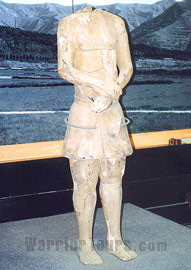- Big Wild Goose Pagoda & Tang Dynasty Palace
- Bell/Drum Tower & Daxingshan Temple
- City Wall
- Forest of Stone Steles Museum & Banpo Museum
- Great Mosque
- Huaqing Hot Springs & Xingjiao Temple
- Mausoleum of the First Qin Emperor
- Mausoleum of Western Han Emperor Liu Qi
- Terracotta Warriors
- Shaanxi History Museum
- Small Wild Goose Pagoda
- Famen Temple & Xianyang Museum
- Maoling Mausoleum & Tomb of Huo Qubing
- Mt. Huashan
- Qian Mausoleum & Zhaoling Mausoleum
Mausoleum of Western Han Emperor Liu Qi

Mausoleum of Western Han Emperor Liu Qi, aka Hanyangling, is located in eastern Xianyang City, 22 kilometers from both Xianyang airport and Xian. It is the most eastern of the nine Western Han imperial mausoleums on the Loess Plateau. The Yangling mausoleum is the joint tomb of Liu Qi, the fourth Emperor of the Western Han Dynasty (206 B.C.-220A.D.) and his Empress, Wang. Empress Wang, mother of the Famous Han Wudi, died in 126 B.C. and was buried in Yangling alongside her husband's tomb.
Construction of the mausoleum took 28 years, beginning in 153 B.C. and ending when the empress died. The mausoleum covers an area of more than 10 square kilometers - nearly six kilometers east to west, and up to three kilometers north to south. The tomb complex is symmetrically constructed with the sacred road from east to west. Yang Ling mausoleum, standing at the western end of the sacred road, is about 32 meters high with circumferences of 670 meters and 238 meters at the bottom and top respectively. It looks like a topless pyramid. Beside it is the tomb of the Empress. In ancient China it was the custom that an Empress, although she held much power, be buried separately from her husband.
Around the mausoleum in all directions are 81 satellite tombs different sizes. From these tombs we have unearthed approximately 60,000 burial objects, including painted nude pottery figurines, utensils, chariots, weapons, and a large number of pottery animals. Also discovered was the largest human sacrifice graveyard ever found in China. A total of 5,000 sacrificial burial tombs have been verified, and the graveyard covers a total area of 3.5 square km.

Han figurines were first modeled as nude bodies, then painted with hair and skin, fitted with movable wooded arms and hands, and finally covered with beautiful clothes before being buried. Over the centuries, the clothing was damaged and the wooden arms rotted. But the colors remain as bright as when they were first painted. The figurines, including cavalrymen, infantrymen, court maids, and servants, are 62 centimeters tall. They have (male or female) sex organs, navels and all the functional bodily orifices. With different facial expressions, these pottery figures look relaxed but dignified. The animal figurines include strong and tough cattle, shrewd dogs, glazed cocks and hens, pigs, and sheep all made in a vivid and lively style.
Three hundred meters southeast of the mausoleum stands a piece of stone shaped like a mill stone and topped with a cross. The local people call it Luopanshi, while others hold that the stone was a sundial showing the time for the tomb-keeper to offer sacrifices to the deceased Emperor.
Among the burial objects unearthed from in and around the, the most noteworthy is a 'go board'. Archeologists assume that, even before the Western Han dynasty, Chinese people began to play 'go' as a recreational activity. They also assume that 'go' originated from China.
| Admission Fee: | CNY 90 (Peak Season) CNY 65 (Low Season) |

